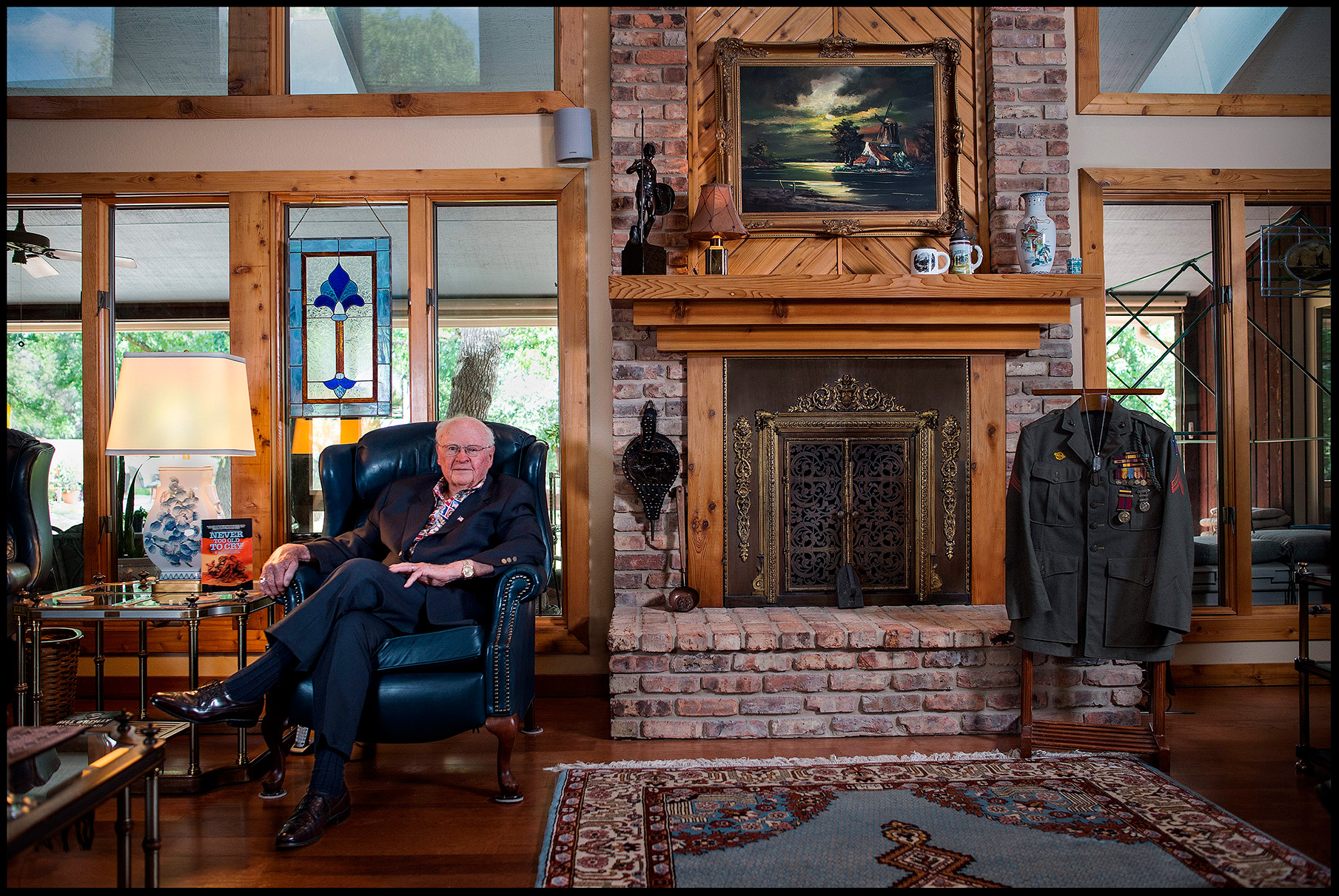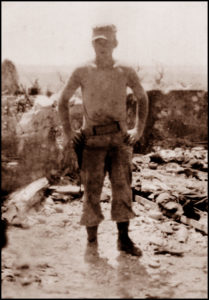
Mac McWilliams
Peleliu & Okinawa veteran
Mac McWilliams
Corporal, USMC
1943–1946

Cpl. Mac McWilliams
Okinawa, 1945
On Okinawa for 82 days we fought the entrenched Japanese soldiers every foot of the way, and the staggering number of people that were killed, missing and wounded convinced President Truman to use the first atomic bomb.
I was born in Ballinger, Texas in 1925. Dad was elected sheriff in Runnels County in 1924, and they were constructing a new jail. When it was finished in 1925, my family moved into the jail. I was just an infant, and my younger brother Billy was born there in 1928. We lived in the jail for six years.
I joined the Marines in March 1943 when I was 17. The Army and Navy really didn’t have a pull for me; the Marines did. I wanted to try that on. We joined for the duration of the war and six months. How does the Marine Corps take 17-year-old boys and turn them into Marines; men that can take Guadalcanal, Peleliu, Iwo Jima and the Chosin Reservoir? They not only capture their bodies; they capture their minds. The drill instructors break you down, then build you back up.
On December 26, 1943 our 5th Infantry Regiment of the 1st Marine Division landed on the swampy shore of Cape Gloucester, New Britain—my first combat mission where for over four months we fought the forever rain, tangled jungle, crocodiles, and snakes as well as the Japanese soldiers and snipers who crouched in the trees. I was a rifleman and carried a BAR.
We landed on Peleliu on September 15, 1944. It was a terrible fight. The 1st Marine Division was severely mauled and it remained out of action until the invasion of Okinawa in April, 1945. In total, the 1st Marine Division suffered over 6,500 casualties during their month on Peleliu—over 1⁄3 of their entire division. In the United States, this was a controversial battle because of the island’s questionable strategic value and the high casualty rate, which exceeded that of all other amphibious operations during the Pacific War. The National Museum of the Marine Corps called it “the bitterest battle of the war for the Marines”. My best friend was killed on the last day of fighting. He was only 18 years old.
My last battle in the Pacific, and one of the most deadly, was at Okinawa—an island only 400 miles from the Japanese homeland. On April 1st, 1945, Easter Sunday which was also April Fool’s Day, we landed on the western shores of Okinawa. For the next 82 days we fought the entrenched Japanese soldiers every foot of the way, and the staggering number of people that were killed, missing and wounded convinced President Truman to use the first atomic bomb. I was on Okinawa when the bombs were dropped on Japan, and after the surrender, our group was sent to China to disarm the Japanese troops that were still there.
There were ten children in my family, and five of us served in the military during World War II. I was in the Marines, a sister was in the WAC’s, a brother in the Navy, who won a Silver Star for his bravery, and two brothers in the Army. One of my brothers in the Army, who is buried at the National Cemetery in Anzio, Italy, was posthumously awarded a Silver Star and two Purple Hearts. My best day in the Marine Corps was when the war ended. My worst day was when my best friend was killed on Peleliu.
After my discharge in 1946, I returned to Texas Tech University and earned BS and MS degrees in Petroleum and Civil Engineering. I spent the next 40 years working in the oil fields in Europe, Africa, the Arctic, North Sea, and the U.S. I have written two books regarding my experience in the Pacific battles and in China: “Never Too Old to Cry” and “Courage of a Small Town Son”. I’m in my 90’s and I still give talks about my experiences during the war. I am fortunate; I’ve been married to Maggie for 69 years. {06-04-2014 • Fair Oaks Ranch, TX}